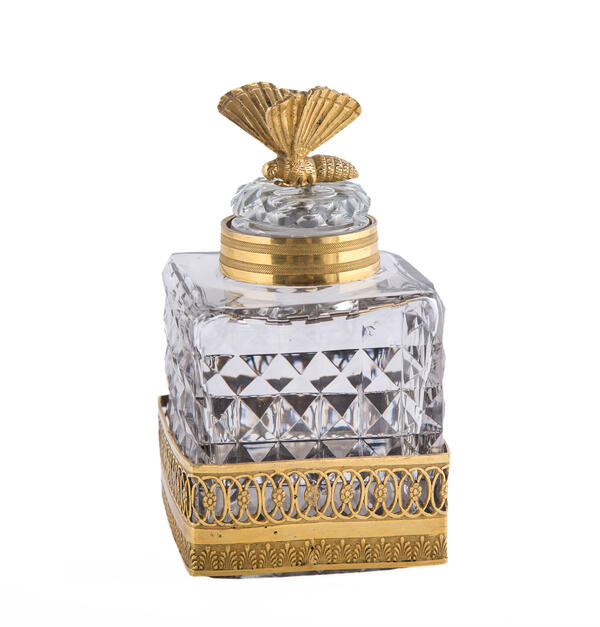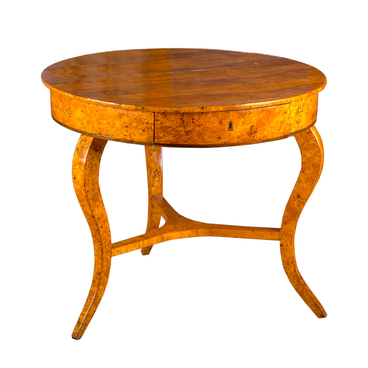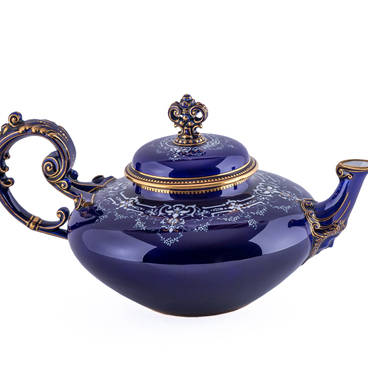The crystal teapot was brought to the museum in 1918 from the Karacharovsky estate of the Counts Uvarov.
In the Russian nobility, tea was often drunk with milk, usually from a porcelain or silver service. Tea was served dry, in a special teapot, and brewed directly at the table.
It was probably made at the Imperial Glass Factory in the 1830s-1850s. The teapot is made of colorless crystal with a diamond facet in the form of pyramidal elements “simple stone”. The combination of transparent sparkling lead glass and gilded bronze gives a special grace to the item. The bronze details are highly artistically executed: a ring on the neck with two bars of lattice, a grip on the lid in the form of butterfly with half-lowered wings and a base with carved acanthus leaves and an openwork lattice with flowers.
The artistic solution is characteristic of the Empire style — the purity and brilliance of crystal and the warm glow of gilded bronze complement and emphasize the beauty of completely different materials: glass and metal.
Lead glass is quite soft and fusible, but heavy, it has a strong gloss and a high refractive index, by analogy with a rock crystal it was called “crystal”. The faceting technique also gives the lead glass a resemblance to stone. In the XVII century, the English glassmaker George Ravenscroft (1618-1681) was the first to make transparent lead glass dishes on an industrial scale. At the turn of the XVIII-XIX centuries, leaded glass became widely used. Since the beginning of the XIX century, the Imperial Glass Factory began to produce objects with facets of lead glass. Furnaces for cooking lead glass according to the English formula were built in 1804. The “faceted” or “Ministerial” service, ordered in England for the highest Court, inspired Russian masters to cut with a “pyramidal stone”. In the future, only the Imperial Glass Factory produced real lead crystal, while all private factories produced well-cleaned lead-free glass, which was also called crystal.
It was probably made at the Imperial Glass Factory in the 1830s-1850s. The teapot is made of colorless crystal with a diamond facet in the form of pyramidal elements “simple stone”. The combination of transparent sparkling lead glass and gilded bronze gives a special grace to the item. The bronze details are highly artistically executed: a ring on the neck with two bars of lattice, a grip on the lid in the form of butterfly with half-lowered wings and a base with carved acanthus leaves and an openwork lattice with flowers.
The artistic solution is characteristic of the Empire style — the purity and brilliance of crystal and the warm glow of gilded bronze complement and emphasize the beauty of completely different materials: glass and metal.
Lead glass is quite soft and fusible, but heavy, it has a strong gloss and a high refractive index, by analogy with a rock crystal it was called “crystal”. The faceting technique also gives the lead glass a resemblance to stone. In the XVII century, the English glassmaker George Ravenscroft (1618-1681) was the first to make transparent lead glass dishes on an industrial scale. At the turn of the XVIII-XIX centuries, leaded glass became widely used. Since the beginning of the XIX century, the Imperial Glass Factory began to produce objects with facets of lead glass. Furnaces for cooking lead glass according to the English formula were built in 1804. The “faceted” or “Ministerial” service, ordered in England for the highest Court, inspired Russian masters to cut with a “pyramidal stone”. In the future, only the Imperial Glass Factory produced real lead crystal, while all private factories produced well-cleaned lead-free glass, which was also called crystal.



